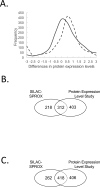Large-Scale Analysis of Breast Cancer-Related Conformational Changes in Proteins Using SILAC-SPROX
- PMID: 28673085
- PMCID: PMC5605765
- DOI: 10.1021/acs.jproteome.7b00283
Large-Scale Analysis of Breast Cancer-Related Conformational Changes in Proteins Using SILAC-SPROX
Abstract
Proteomic methods for disease state characterization and biomarker discovery have traditionally utilized quantitative mass spectrometry methods to identify proteins with altered expression levels in disease states. Here we report on the large-scale use of protein folding stability measurements to characterize different subtypes of breast cancer using the stable isotope labeling with amino acids in cell culture and stability of proteins from rates of oxidation (SILAC-SPROX) technique. Protein folding stability differences were studied in a comparison of two luminal breast cancer subtypes, luminal-A and -B (i.e., MCF-7 and BT-474 cells, respectively), and in a comparison of a luminal-A and basal subtype of the disease (i.e., MCF-7 and MDA-MB-468 cells, respectively). The 242 and 445 protein hits identified with altered stabilities in these comparative analyses included a large fraction with no significant expression level changes. This suggests thermodynamic stability measurements create a new avenue for protein biomarker discovery. A number of the identified protein hits are known from other biochemical studies to play a role in tumorigenesis and cancer progression. This not only substantiates the biological significance of the protein hits identified using the SILAC-SPROX approach, but it also helps elucidate the molecular basis for their disregulation and/or disfunction in cancer.
Keywords: BT-474; MCF-7; MDA-MB-468; chemical denaturation; protein folding.
Figures




Similar articles
-
Proteome-Wide Structural Biology: An Emerging Field for the Structural Analysis of Proteins on the Proteomic Scale.J Proteome Res. 2018 Nov 2;17(11):3614-3627. doi: 10.1021/acs.jproteome.8b00341. Epub 2018 Oct 8. J Proteome Res. 2018. PMID: 30222357 Free PMC article. Review.
-
Global analysis of protein folding thermodynamics for disease state characterization.J Proteome Res. 2015 May 1;14(5):2287-97. doi: 10.1021/acs.jproteome.5b00057. Epub 2015 Apr 9. J Proteome Res. 2015. PMID: 25825992 Free PMC article.
-
Proteome-Wide Characterization of Phosphorylation-Induced Conformational Changes in Breast Cancer.J Proteome Res. 2018 Mar 2;17(3):1129-1137. doi: 10.1021/acs.jproteome.7b00795. Epub 2018 Jan 30. J Proteome Res. 2018. PMID: 29332387 Free PMC article.
-
Discovery of Tamoxifen and N-Desmethyl Tamoxifen Protein Targets in MCF-7 Cells Using Large-Scale Protein Folding and Stability Measurements.J Proteome Res. 2017 Nov 3;16(11):4073-4085. doi: 10.1021/acs.jproteome.7b00442. Epub 2017 Oct 11. J Proteome Res. 2017. PMID: 28927269 Free PMC article.
-
Apoptosis Markers in Breast Cancer Therapy.Adv Clin Chem. 2016;74:143-93. doi: 10.1016/bs.acc.2015.12.003. Epub 2016 Jan 19. Adv Clin Chem. 2016. PMID: 27117663 Review.
Cited by
-
Comparative Analysis of Protein Folding Stability-Based Profiling Methods for Characterization of Biological Phenotypes.J Am Soc Mass Spectrom. 2023 Mar 1;34(3):383-393. doi: 10.1021/jasms.2c00248. Epub 2023 Feb 20. J Am Soc Mass Spectrom. 2023. PMID: 36802530 Free PMC article.
-
Protein Folding Stability Profiling of Colorectal Cancer Chemoresistance Identifies Functionally Relevant Biomarkers.J Proteome Res. 2023 Jun 2;22(6):1923-1935. doi: 10.1021/acs.jproteome.3c00045. Epub 2023 May 1. J Proteome Res. 2023. PMID: 37126456 Free PMC article.
-
Large-scale characterization of drug mechanism of action using proteome-wide thermal shift assays.Elife. 2024 Nov 11;13:RP95595. doi: 10.7554/eLife.95595. Elife. 2024. PMID: 39526730 Free PMC article.
-
Proteome-Wide Structural Biology: An Emerging Field for the Structural Analysis of Proteins on the Proteomic Scale.J Proteome Res. 2018 Nov 2;17(11):3614-3627. doi: 10.1021/acs.jproteome.8b00341. Epub 2018 Oct 8. J Proteome Res. 2018. PMID: 30222357 Free PMC article. Review.
-
Analysis of Brain Protein Stability Changes in Mouse Models of Normal Aging and α-Synucleinopathy Reveals Age- and Disease-Related Differences.J Proteome Res. 2021 Nov 5;20(11):5156-5168. doi: 10.1021/acs.jproteome.1c00653. Epub 2021 Oct 4. J Proteome Res. 2021. PMID: 34606284 Free PMC article.
References
-
- Geiger T, Madden SF, Gallagher WM, Cox J, Mann M. Proteomic portrait of human breast cancer progression identifies novel prognostic markers. Cancer Res. 2012;72(9):2428–39. - PubMed
-
- Bateman NW, Sun M, Hood BL, Flint MS, Conrads TP. Defining central themes in breast cancer biology by differential proteomics: conserved regulation of cell spreading and focal adhesion kinase. J. Proteome Res. 2010;9(10):5311–24. - PubMed
-
- Calderon-Gonzalez KG, Rustarazo MLV, Labra-Barrios ML, Bazan-Mendez CI, Tavera-Tapia A, Herrera-Aguirre ME, del Pino MMS, Gallegos-Perez JL, Gonzalez-Marquez H, Hernandez-Hernandez JM, Leon-Avila G, Rodriguez-Cuevas S, Guisa-Hohenstein F, Luna-Arias JP. Determination of the protein expression profiles of breast cancer cell lines by quantitative proteomics using iTRAQ labelling and tandem mass spectrometry. J. Proteomics. 2015;124:50–78. - PubMed
-
- Kulasingam V, Diamandis EP. Proteomics analysis of conditioned media from three breast cancer cell lines: a mine for biomarkers and therapeutic targets. Mol. Cell. Proteomics. 2007;6(11):1997–2011. - PubMed
Publication types
MeSH terms
Substances
Grants and funding
LinkOut - more resources
Full Text Sources
Other Literature Sources
Medical
Molecular Biology Databases
Miscellaneous

